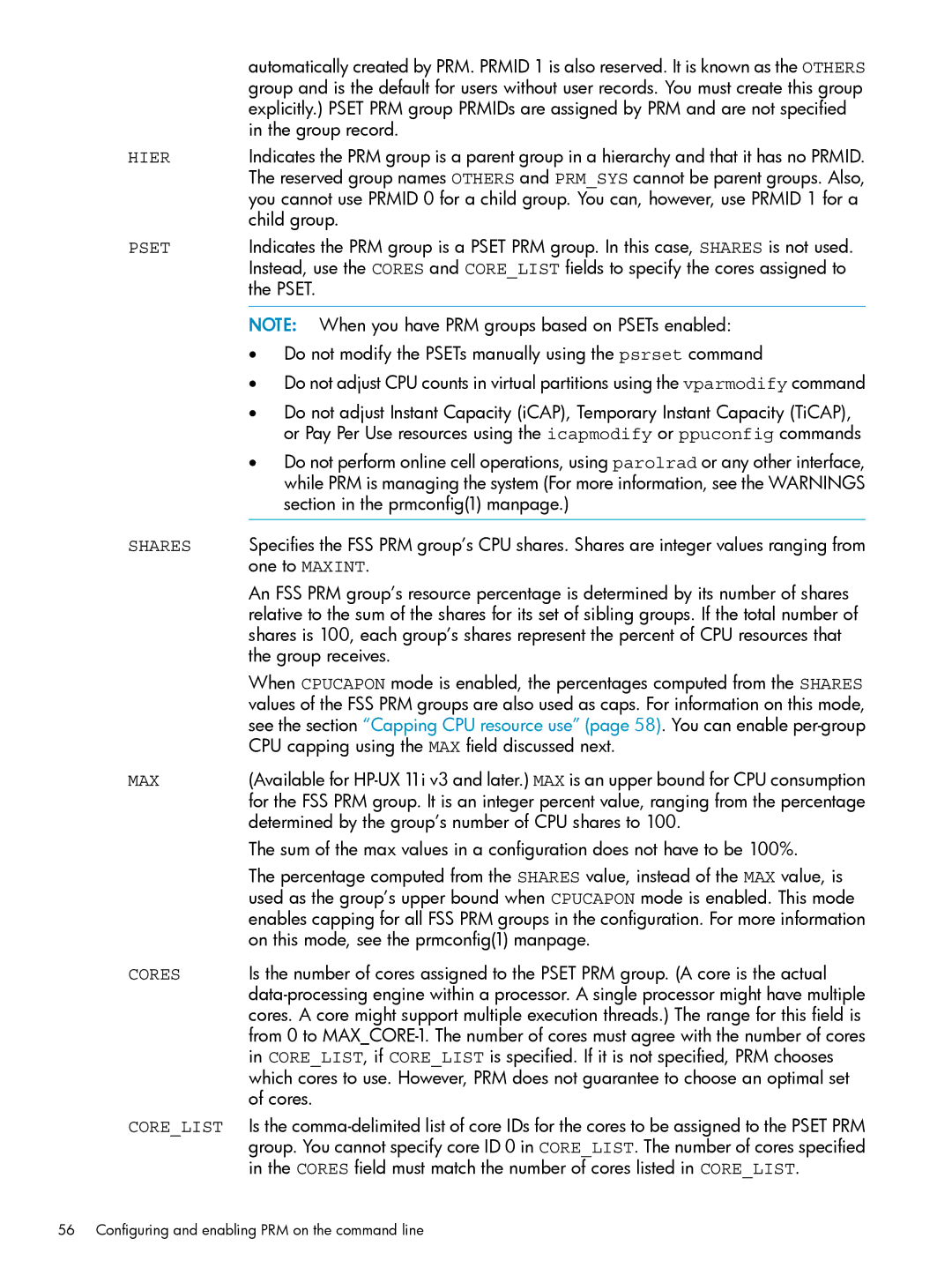
| automatically created by PRM. PRMID 1 is also reserved. It is known as the OTHERS |
| group and is the default for users without user records. You must create this group |
| explicitly.) PSET PRM group PRMIDs are assigned by PRM and are not specified |
| in the group record. |
HIER | Indicates the PRM group is a parent group in a hierarchy and that it has no PRMID. |
| The reserved group names OTHERS and PRM_SYS cannot be parent groups. Also, |
| you cannot use PRMID 0 for a child group. You can, however, use PRMID 1 for a |
| child group. |
PSET | Indicates the PRM group is a PSET PRM group. In this case, SHARES is not used. |
| Instead, use the CORES and CORE_LIST fields to specify the cores assigned to |
| the PSET. |
NOTE: When you have PRM groups based on PSETs enabled:
•Do not modify the PSETs manually using the psrset command
•Do not adjust CPU counts in virtual partitions using the vparmodify command
•Do not adjust Instant Capacity (iCAP), Temporary Instant Capacity (TiCAP), or Pay Per Use resources using the icapmodify or ppuconfig commands
•Do not perform online cell operations, using parolrad or any other interface, while PRM is managing the system (For more information, see the WARNINGS section in the prmconfig(1) manpage.)
SHARES | Specifies the FSS PRM group’s CPU shares. Shares are integer values ranging from |
| one to MAXINT. |
| An FSS PRM group’s resource percentage is determined by its number of shares |
| relative to the sum of the shares for its set of sibling groups. If the total number of |
| shares is 100, each group’s shares represent the percent of CPU resources that |
| the group receives. |
| When CPUCAPON mode is enabled, the percentages computed from the SHARES |
| values of the FSS PRM groups are also used as caps. For information on this mode, |
| see the section “Capping CPU resource use” (page 58). You can enable |
| CPU capping using the MAX field discussed next. |
MAX | (Available for |
| for the FSS PRM group. It is an integer percent value, ranging from the percentage |
| determined by the group’s number of CPU shares to 100. |
| The sum of the max values in a configuration does not have to be 100%. |
| The percentage computed from the SHARES value, instead of the MAX value, is |
| used as the group’s upper bound when CPUCAPON mode is enabled. This mode |
| enables capping for all FSS PRM groups in the configuration. For more information |
| on this mode, see the prmconfig(1) manpage. |
CORES | Is the number of cores assigned to the PSET PRM group. (A core is the actual |
| |
| cores. A core might support multiple execution threads.) The range for this field is |
| from 0 to |
| in CORE_LIST, if CORE_LIST is specified. If it is not specified, PRM chooses |
| which cores to use. However, PRM does not guarantee to choose an optimal set |
| of cores. |
CORE_LIST | Is the |
| group. You cannot specify core ID 0 in CORE_LIST. The number of cores specified |
| in the CORES field must match the number of cores listed in CORE_LIST. |
56 Configuring and enabling PRM on the command line
